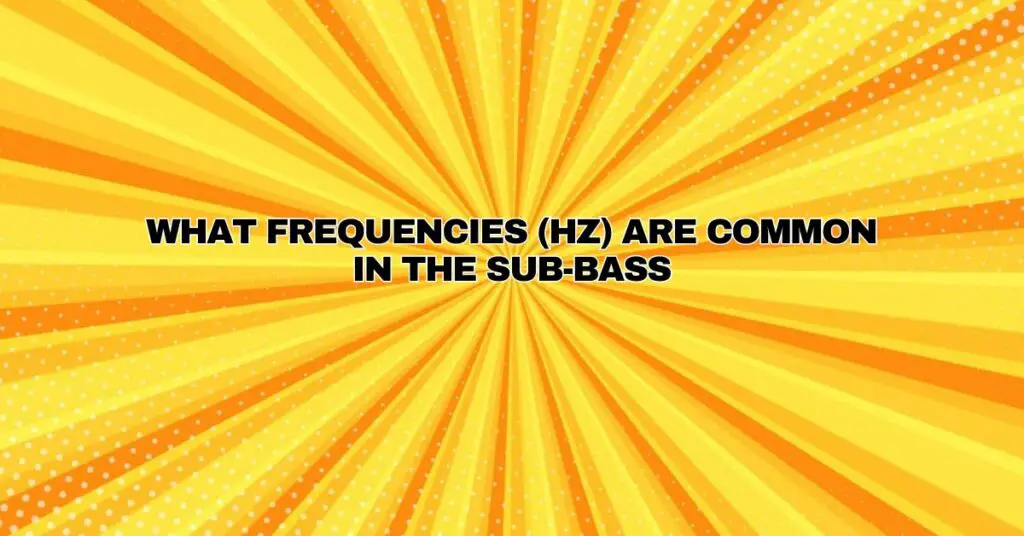In the world of music and audio, the pursuit of powerful and impactful sub-bass frequencies is a shared fascination among audiophiles, music producers, and sound engineers. Sub-bass, which includes the lowest frequencies in the audio spectrum, plays a pivotal role in shaping the visceral and emotional dimensions of sound. This comprehensive article explores the common frequencies in sub-bass, delving into the range, its significance in various musical genres, and the technologies employed to reproduce these frequencies with precision.
Understanding Sub-Bass Frequencies
Sub-bass, often described as “bass,” encompasses the lowest frequencies that can be heard and felt in audio. These frequencies are responsible for creating sensations of power, depth, and resonance, often producing a visceral response. Sub-bass frequencies generally fall below 60 Hertz (Hz) and can be classified into three primary categories:
- Sub-Bass (20-60 Hz): These frequencies provide the deep, foundational elements of sound. Sub-bass is often felt as a physical vibration and sets the tone for a powerful and immersive audio experience.
- Super Sub-Bass (Below 20 Hz): Frequencies below 20 Hz are considered super sub-bass or infrasound. While they may not be audibly perceived by the human ear, they can be felt and can contribute to the physical impact of audio, particularly in large sound systems and subwoofers.
- Deep Sub-Bass (Below 10 Hz): Frequencies below 10 Hz are recognized as deep sub-bass. These are at the extreme low end of the spectrum, creating profound sensations that are more akin to vibrations than audible sound.
Common Sub-Bass Frequencies in Music
The frequency range of sub-bass is incredibly versatile and its utilization varies across different musical genres. Common sub-bass frequencies in music include:
- EDM (Electronic Dance Music): EDM often leverages sub-bass frequencies in the 30-60 Hz range. These frequencies provide the driving force behind the pulsating, energetic basslines that characterize electronic genres like house, trance, and techno.
- Hip-Hop and Rap: Hip-hop and rap music rely on sub-bass frequencies, typically between 30-40 Hz and below. These frequencies give the basslines a deep and resonant quality, contributing to the genre’s signature punch.
- Rock and Metal: While rock and metal genres may not emphasize sub-bass as much as electronic or hip-hop, they still benefit from a well-defined low end. Sub-bass frequencies in the 40-80 Hz range add depth and impact to the music.
- Movie Soundtracks: In the realm of movie soundtracks, sub-bass frequencies are essential for creating the cinematic experience. Frequencies in the 20-60 Hz range are often used to create the rumbling, immersive bass that accompanies explosions, intense moments, and deep soundscapes.
- Classical Music: Even classical music, with its wide dynamic range, can incorporate sub-bass frequencies to add depth and gravitas to orchestral compositions. These may fall within the 30-60 Hz range.
Technologies for Sub-Bass Reproduction
Reproducing sub-bass frequencies accurately and with precision requires advanced audio technologies. These include:
- Subwoofers: Subwoofers are specialized loudspeakers designed to reproduce low-frequency sound accurately. They are available in various sizes and power ratings to handle different sub-bass requirements.
- Bass Management Systems: In home theater systems and professional audio setups, bass management systems are used to route low-frequency content to subwoofers and to balance the overall audio spectrum.
- Amplifiers: High-quality amplifiers are crucial for driving subwoofers and ensuring that sub-bass frequencies are delivered with clarity and power.
- Room Calibration: Advanced audio systems may include room calibration technologies that analyze room acoustics and adjust sub-bass frequencies to mitigate standing waves and resonances.
Conclusion
Sub-bass frequencies are the foundation of impactful, immersive audio experiences. Their utilization varies across different musical genres, but the common thread is the ability to create sensations that transcend mere sound. The art of crafting sub-bass is about precision, power, and emotional resonance, and it relies on advanced audio technologies and equipment to deliver the desired impact. Whether you’re a music enthusiast, a producer, or an audio professional, understanding the common frequencies in sub-bass is key to appreciating the depth and power that music and sound can offer.


